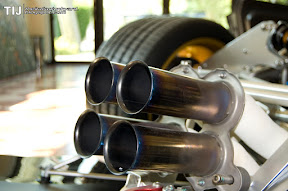Tuesday, March 22, 2011
17.4 The Da Vinci Code, Pagani edition: an interview with Horacio Pagani, PART 3
Back on Pagani’s side of the supercar universe, we carry on our extensive interview with founder and genius Horacio pagani. Should you need a recap, here are PART 1 and PART 2.
Eventually we came to talk about workers. There are only a few people which are over 40, while the rest are pretty young, requiring Pagani to personally train them within the company. There is one sole engineer, in charge of the electronics and of the relations with Mercedes-Benz. This of course led me to question my choice to study automotive engineering.
Pagani agrees that our national network of universities has lost a bit of its main purpose, which is educating people capable of creating something new, rather than simply piling more information on previous lectures. As far as engineering is concerned, the university’s framework leaves little space for actually being ingenious. Despite being a problem felt in many other countries, Italy probably has it worse off because we, as students, are not provided with internships within local factories and companies beginning in the first year of university. Actually, only a select few of us will get to work in an external company during the specialization degree dissertation (comparable to a Masters degree). So once we are done with university, we are left with a very limited but superfluously theoretical knowledge.
Digressing a little… regardless, be sure to make the jump to keep reading how Pagani mixes art and engineering to create his masterpieces.
Pagani’s aspiration for his own career would be to carry on Da Vinci’s approach trying to merge aesthetics and engineering. In this way there will be an exchange between the two fields, with designers trying to create objects in which form is not so predominant over function, and engineers trying to design something which is extremely efficient, but also pleasing to own or use. That should bring more stimuli to both figures, and give us better objects, more functional but also passionate, more communicative. Incidentally, in the Italian language a “stilista” or designer is in charge of the aesthetical aspect of an object. What Pagani tries to achieve is basically a designer both from the English and the Italian point of view.
Curiously enough, he quotes Toyota’s Design Director which is also Quality Control Manager. These two fields couldn’t be farther apart, yet quality, from an engineering point of view, also starts with the aesthetical quality of an object, such as a car’s bodywork. Ironically, the whole automotive world, media and enthusiasts mainly, keeps on blindly blaming Toyota for the recent “unintended acceleration” problems. Not only is this situation is getting better for Toyota considering recent breakthroughs from the investigations at NASA, but every time I have a chance to talk about someone actually into the automotive business, they never mention this situation and actually praise Toyota for their methods and achievements.
Regardless, the key seems to be the approach to whatever your role might be. It has to go deeper than simply following through with the assigned task. It should be well-rounded, more global, where one takes into consideration aspects that might be pertinent to other positions, other figure. So, in an era when what used to be a one man job is now subdivided between a group of workers, being capable of having the same points of view of that single man is the key to realize something “better”, something more complete.
So Leonardo Da Vinci is not simply an inspiration, but the foundation of Pagani’s philosophy on how education and work should be. I just couldn’t agree more.
After more than an hour of pleasant conversation with Mr Pagani, I left his office quite inspired by his words and his attitude. I always admired his achievements, his way of working and his personality, and I was extremely happy to have verified all of this first hand. When the interview was over, we took some more minutes to talk about… my neck brace, which I was wearing because of recurrent pain after an accident I had a few years ago. He was so kind to even provide me a couple of tips on that too, and the name of a Doctor specialized in this field. It may have little to do with designing cars, but it shows you how you have to be a good person if you want to be a good worker too.
The only letdown is that he didn’t offer me a job at the end of the interview, but to be fair I didn’t ask for one either.
My bad then, next time possibly.
I’d really like to thank Sarajane for helping me and taking many of the shots featured here, and both Wouter and Pieter Melissen from UltimateCarPage for giving me the chance of doing this interview also on their behalf.
You can read their reports over here: Horacio Pagani and his dream of carbon fiber.
It’s not over though, as PART 4 is coming next. In that last chapter you’ll find out all the processes to build your own Zonda, in case you’re rich enough to afford one and at the same time willing to get your hands dirty at the factory. Stay tuned.
All Pictures Copyright: Damiano Garro and Sarajane Bradshaw for The Italian Junkyard
Etichette:
2 Italian Cents,
carbon fiber,
Ceramic,
design,
engineering,
factory visit,
Huayra,
Interview,
Modena,
one-off,
Pagani,
photoshoot,
review,
style,
ultimatecarpage.com,
Zonda
Subscribe to:
Post Comments (Atom)





























































No comments:
Post a Comment